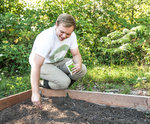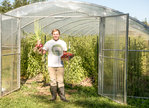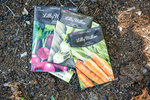


The August garden evokes images of a bountiful harvest — juicy red tomatoes, abundant squash, sweet ears of yellow corn — and the finale of the growing season.
But late summer is the perfect time for round two, a second season in the garden which will yield vegetables until the first frost and beyond.
Erik Halvorson at Halvorson Farms in Yacolt grows market vegetables and fruits for farmer’s markets, restaurants, and the Clark County Food Bank, as well as tending a household garden which yields produce through the year.
There are advantages to planting in late summer, said Halvorson. The soil is already warm, so seeds can be sown directly outdoors. And many pests and diseases have run their course, leaving plants generally untroubled into the fall. The greatest challenge of late summer planting in the Pacific Northwest is keeping seeds and young plants moist.
Choose plants for the fall garden by checking their “days to maturity,” which will be printed on the seed packet, said Halvorson. In Battle Ground, there is a 50 percent chance of a first frost by Oct. 13, and a 90 percent chance of first frost by Oct. 29. Calculate the number of days from planting until first frost, and choose vegetables which will mature within that time.
Some plants are better suited to the fall garden than others, said Halvorson. Greens mature quickly and are edible when harvested young — in fact, many people prefer them that way.
Arugula can be planted every two weeks until Sept. 22 to produce a steady harvest. Baby lettuce greens are ready to harvest in only 21 days, and are fully mature in 40 days. And spinach is a great late season crop, thriving in temperatures as low as the 30s.
Succession planting refers to planting a crop over time, to ensure an ongoing harvest. This is an ideal way to maximize the yield for crops like lettuce, which mature quickly and have a short harvest.
Late season radishes have a milder flavor than those which mature in the heat of summer, said Halvorson. And the peppery root vegetables grow from seed to harvest in only 25 days.
Carrots thrive into the fall, if you can just get them started in the dry heat of summer.
“Try to find a variety that has a short ‘Days to Maturity,’ such as ‘Baby Finger’” said Halvorson.
“Carrots are the most difficult to get to germinate,” said Halvorson. “The tiny seeds don’t like to dry out and they like it dark. And, they are hard to see.”
Halvorson recommends mulching heavily over sown carrots, or laying cardboard over the bed. Check them every couple of days and pull back the cardboard as soon as they begin to sprout.
Many vegetables actually taste better after a frost or two, notably members of the cabbage family such as kohlrabi, kale or brussels sprouts. Root vegetables can be mulched and left in the ground, to be harvested through the winter.
Fall is also time to plant with next summer in mind. Garlic goes into the ground in the fall for harvest the following summer. “Hardneck” varieties do best in the wet climate of the northwest, said Halvorson. The downside? They can’t be braided into decorative bunches to dry, he said with a shrug.
Planting a cover crop in the fall will prevent erosion, retain nutrients, and add organic matter to improve soil quality when it is tilled in. “You don’t want to have bare soil,” said Halvorson. He sows winter wheat in dormant fields because it is inexpensive, but also recommends alternatives such as oats, vetch, rye or clover.
When it comes to choosing vegetables for the fall garden, Halvorson offered one more rule. “You should always grow stuff you like to eat,” he said.